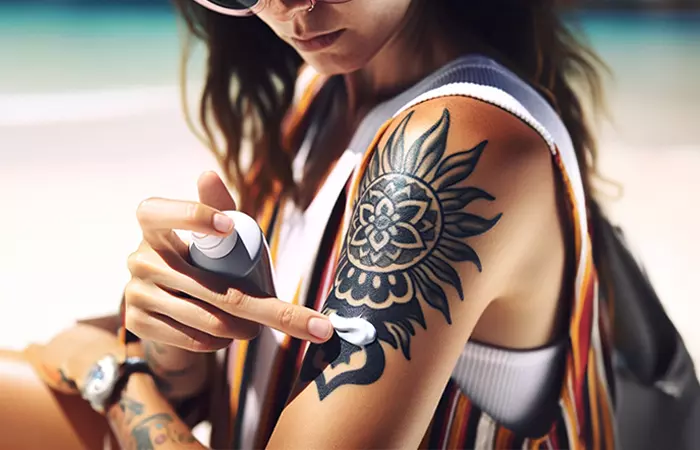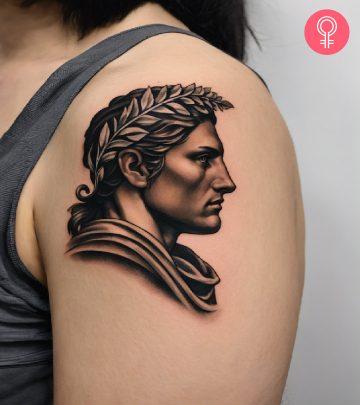How To Protect Tattoos In A Tanning Bed – 6 Tips
Shield your tattoos while you tan your skin with these easy and effective aftercare tips.

Image: Created with Dall·E
If your desire to get a sun-kissed golden glow is irresistible enough to drag you to a tanning salon, understanding how to protect your tattoo in a tanning bed is paramount. Tattoos are intricate artwork on your skin, full of vibrant colors that are meant to stay vibrant over time. While the idea of getting a tan might be tempting, using tanning beds is not the best choice for your tattoos. The strong ultraviolet rays from tanning beds can raise the risk of fading and even changing the chemistry of your tattoo. So, can you prevent tattoo fading under a tanning bed? Well, you can, but you need to take extra precautions before tanning with a new, still-healing tattoo or even an old ink to protect it from the harmful rays.

Keep reading to know more about the risks of using tanning beds as well as tips that can shield your tattoo from UV light.
In This Article
Risks Of Tanning With Tattoos

One of the most important tattoo aftercare advice after getting a fresh ink is that you need to keep it away from direct exposure to sunlight, because ultraviolet rays can cause tattoo fading. Similarly, rays from tanning beds are also a risk factor for tattooed skin. The intensity of the UV rays may split the pigments of the tattoo ink, leading to fading. This process is similar to a laser tattoo removal procedure, where it works by directing light into the skin that gets absorbed by the tattoo pigments, causing them to heat up and break apart (1). When fragmentation occurs, the concentration of pigment particles decreases, leading to the fading of tattoo colors. Moreover, it can alter the chemistry of tattoo pigments, potentially generating toxic decomposition products.
It is essential to understand how new tattoos and sun exposure interact. Both sun exposure and tanning beds trigger a similar result, just in a less intense manner for the former. Tanning beds, unlike natural sunlight, release more concentrated UV radiation, which can lead to a myriad of general health issues, such as photoallergic effects, chronic inflammation, and oxidative stress. Moreover, compounds in tattoo ink, along with their broken down byproducts during UV exposure, might also act as tumor promoters in tattooed skin (2).
 Did You Know?
Did You Know?So then, is it safe to get a tan after getting a tattoo? Be it a new tattoo or an old one, artificially tanning is not a good option. Moreover, the risks may be greater if you are tanning with new tattoos. Keep reading to know more.
Key Takeaways
- UV exposure from sunlight or tanning beds can fade tattoos and pose health risks, especially for fresh inks.
- Wait 5-6 weeks post-tattoo for tanning bed use to reduce the risk of scarring and ensure proper healing.
- Healing periods vary, so consult your tattoo artist if unsure whether your tattoo is healed. Even after healing, exercise caution using tanning beds to prevent tattoo fading and skin issues.
- Shield your tattoo in tanning beds with SPF 30+ sunscreen, tanning lotions with SPF, and covering options like fabric or UV-resistant bandages.
Tanning With New Tattoos

Tanning with new tattoos is more dangerous than older tattoos. Right after the tattooing process, your inked layer of skin is bound to be super sensitive. So, it is best to avoid tanning until your tattoo has completely healed. Exposing fresh tattoos to UV rays (from the sun or tanning beds) can lead to problems like fading, overexposure, and burning, all of which can damage your tattoo. Moreover, it can also slow down the healing process.
Newly tattooed skin is basically an open wound through which the UV rays penetrate the epidermis into the dermis–where the tattoo is situated–which may cause potential health risks, including cancer (2). Also, fresh tattoo ink takes time to settle into the dermis. So, tanning before that may result in the ink pigments leaking out, ruining the tattoo design.
Hence, the best way to optimize the healing process following a new tattoo is to keep it away from the tanning bed as well as the sun.So, can you put sunscreen on a new tattoo? It is also not recommended to apply sunscreen lotion before the tattoo is completely healed, as it may irritate your sensitive skin and extend the healing process for longer. Once your tattoo has finished scabbing, you can use a broad spectrum mineral sunscreen with zinc oxide to protect it. This will act as a protective layer on top of your skin, providing a barrier against UV exposure and retaining tattoo vibrancy.
If you are particular about using a tanning bed, it is important to wait until your fresh tattoo has fully healed to ensure the best results and minimize any potential risks. Check out the next section to know how long this wait period can be.
How Long Do You Have To Wait To Tan After Getting A Tattoo?
It is best to wait 5 to 6 weeks after getting a new tattoo before exposing it to direct UV rays from a tanning bed. Even if your skin appears healed after the third week, it is better to wait until the healing process timeline is complete. Your skin is sensitive during this time, and by taking the leap you might risk burning your skin, resulting in permanent scarring and distorted tattoos that cannot be fixed. So, it is better to be patient and wait for the recommended healing time. Understanding the difference between a fresh vs healed tattoo can help you take appropriate measures.
 Quick Tip
Quick TipEven after healing, you should be extremely careful while using a tanning bed to avoid tattoo fading and other skin issues. Scroll down for a few tips that may come in handy in the process.
How To Protect Your Tattoo In A Tanning Bed
1. Apply Sunscreen

Applying a tattoo-friendly, broad-spectrum sunscreen with at least SPF 30 (50 for good measure) may help prevent fading and protect your tattoo in a tanning bed. Ensure it is a good quality product with moisturizing ingredients like aloe vera and glycerin that help maintain the vibrancy of the tattoo. Also, look for minerals like zinc oxide and titanium dioxide that offer good coverage and are gentle on the skin. You may use a cotton swab to apply sunscreen directly on your tattooed skin.
2. Use Tanning Lotion With SPF

Using a tanning lotion specifically designed for tattoos can be useful in preventing fading. Look for lotions that are formulated with SPF to provide extra protection for your tattooed skin during tanning sessions. However, you may also apply sunscreen after applying the tanning lotion for added protection.
3. Cover The Tattoo

- Fabric
You may cover your tattooed skin with fabric before using the tanning bed. Cut a fabric piece matching your tattoo shape and secure it with medical tape for precise coverage. Ensure the fabric is breathable, protecting your tattoo while allowing the skin to breathe.
- Stickers
Using a sticker on top of the tattoo may also be a good idea to protect it from UV light. Pick a sticker as per the size and shape of your tattoo and stick it to the tattooed area. Always do a patch test with the sticker to ensure your skin does not react to the adhesive. Mind you, this process will also end up giving you a tanning tattoo, which is basically tan lines formed in the shape of the sticker.
- Adhesive Bandage
Opt for a UV-resistant adhesive bandage before the tanning session to cover your tattoo. Look for bandages designed specifically for tattoo protection, ensuring they offer UV-blocking properties for an additional layer of defense against potential fading and damage during tanning sessions.
- Other Covering Options
For foot tattoos, you can wear an ankle sock, while a sweatband will do the work for the small tattoos around the ankle, calves, forearms, and wrists. If the tattoo is large, it is best to use a t-shirt to cover it. A bathing suit can help cover tattoos near the hip, buttocks, lower back, and stomach, while a sarong can help block the rays for a thigh tattoo.
When considering hopping into a tanning bed with tattoos, it is vital to know what happens if you do not protect it while doing so. Both natural sunlight and tanning beds release UV radiation that causes tattoo fading and other skin issues. Also, tanning with new tattoos is not safe either, as the healing skin is more sensitive during this stage and may cause premature fading and extended healing times. Applying sunscreen, particularly with at least SPF 30 or more, is a simple yet effective measure to protect your tattoo. You may also consider covering your tattoo with fabric, stickers, or adhesive bandages for a comprehensive defense strategy during tanning sessions.
Frequently Asked Questions
What should I do if my tattoo gets sunburned in a tanning bed?
If your tattoo gets sunburned in a tanning bed, treat it gently to aid healing. Apply a soothing, fragrance-free moisturizer and avoid exposing the sunburned tattoo to further UV radiation. Keep the area clean and avoid picking at any peeling skin. If the sunburn persists or shows signs of infection, consult with a healthcare professional.
What happens if I do not cover my tattoo in a tanning bed?
If you do not cover your tattoo in a tanning bed, it may fade, the colors may get distorted, and you may experience skin irritation or sunburn. There are a few ways to cover a tattoo, from using stickers and sweat bands to bathing suits; you can choose one that suits your needs to keep yourself protected from adverse effects.
Tattoos are susceptible to damage in tanning beds, but how badly do they get affected and how can you prevent it? Watch this video to learn more about the consequences and a few handy tips to help you out.
References
Articles on StyleCraze are backed by verified information from peer-reviewed and academic research papers, reputed organizations, research institutions, and medical associations to ensure accuracy and relevance. Read our editorial policy to learn more.
- Laser treatment of tattoos: Basic principles
https://pubmed.ncbi.nlm.nih.gov/28288450/ - Cutaneous malignancies in tattoos, a case series of six patients
https://www.ncbi.nlm.nih.gov/pmc/articles/PMC8628776/ - Reasons for using indoor tanning devices: A systematic review of qualitative evidence
https://www.ncbi.nlm.nih.gov/pmc/articles/PMC10084128/
Read full bio of Rodrigo Casco
Read full bio of Shreya Mukherjee
Read full bio of Madhumati Chowdhury
Read full bio of Gazala Firdos Ansari























Community Experiences
Join the conversation and become a part of our empowering community! Share your stories, experiences, and insights to connect with other beauty, lifestyle, and health enthusiasts.